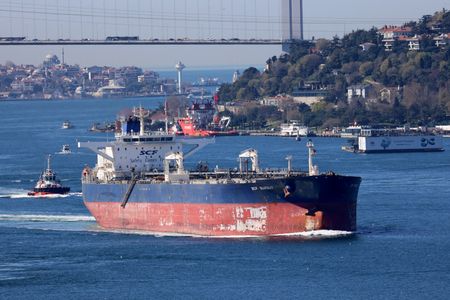By Siyi Liu and Chen Aizhu
SINGAPORE (Reuters) – The amount of Russian and Iranian oil held on ships has hit multi-month highs as harsher U.S. sanctions reduced the number of buyers, leaving fewer tankers available to deliver cargoes and driving up crude costs, trade sources and analysts said.
Washington has imposed multiple rounds of sanctions on ships and entities dealing with oil from Iran and Russia since October, disrupting trade with major importers China and India.
U.S. President Donald Trump last week restored his “maximum pressure” campaign on Iran that includes efforts to drive its oil exports down to zero in order to stop Tehran from obtaining a nuclear weapon.
The OPEC producer has struggled to attract new vessels to fill the shipping capacity gap since the sanctions were imposed in the fourth quarter, said Xu Muyu, a senior analyst at data analytics firm Kpler.
A ban last month by China’s Shandong Port Group on sanctioned tankers from calling at its ports in the eastern province, home to most of the independent refiners that are the main buyers of Russian and Iranian oil, has also made it difficult for such cargoes to discharge.
Shipbroker Braemar ACM said 57% of the 126 Very Large Crude Carriers (VLCCs) currently involved in Iran’s crude trade to China are already subject to U.S. sanctions.
As exports have risen and deliveries to China have dropped, the amount of Iranian oil in floating storage has expanded by between 10 million and 20 million barrels so far this year, according to three analysts’ estimates.
However, calculations of the total volume of Iranian oil in floating storage vary widely as the analysts use different methodologies to track the so-called shadow fleet.
Data from Kpler showed Iranian oil floating storage at more than 25 million barrels, the highest in more than a year, with about 80% of the cargoes floating off the waters of Singapore and Malaysia.
In contrast, Emma Li, a senior analyst at tanker tracker Vortexa Analytics, estimates the volume of Iranian crude and condensate in floating storage stood at 73.1 million barrels at end-January.
Iran’s exports rose for a second month to 1.78 million barrels in January after hitting a two-year low of 1.45 million in November, she said.
“Smuggling techniques such as deactivating and spoofing AIS transponders and undertaking ship-to-ship transfers means there may be even more Iranian oil starting to float,” said Richard Bronze, head of geopolitics at consultancy Energy Aspects.
With fewer non-sanctioned ships to deliver oil to China, crude prices have climbed.
Discounts for flagship Iranian Light crude have narrowed to 50 cents per barrel against ICE Brent, a multi-year peak, versus discounts of $2.50 per barrel about two months ago, on a delivered ex-ship (DES) basis to Shandong province for a cargo arriving in March, traders said.
RUSSIA
For Russian oil, tougher sanctions imposed a month ago by the outgoing Biden administration have driven up costs for refiners in China and India, with March ESPO Blend crude traded at $2 to $3 above ICE Brent on a DES basis to China, the highest premiums in more than two years, three trade sources said.
And transport costs have soared, too, with fewer vessels available. The cost of shipping oil from Russia’s Far East to north China last stood at around $4.5 million, roughly triple what it was before the latest U.S. sanctions, though down from as high as $7 million shortly after they were announced.
Russian crude-on-water hit a two-month high of 88 million barrels on January 27, 24% higher than on January 10 when the sanctions were announced, Kpler data showed.
The volume has declined since late January as Russian crude exports fell, while some cargoes have discharged, Kpler’s Xu said.
Also, several vessels previously engaged in moving Iranian oil are switching to Russian trade, she added.
(Reporting by Siyi Liu and Chen Aizhu in Singapore; Additional reporting by Jonathan Saul in London; Editing by Florence Tan and Sonali Paul)









